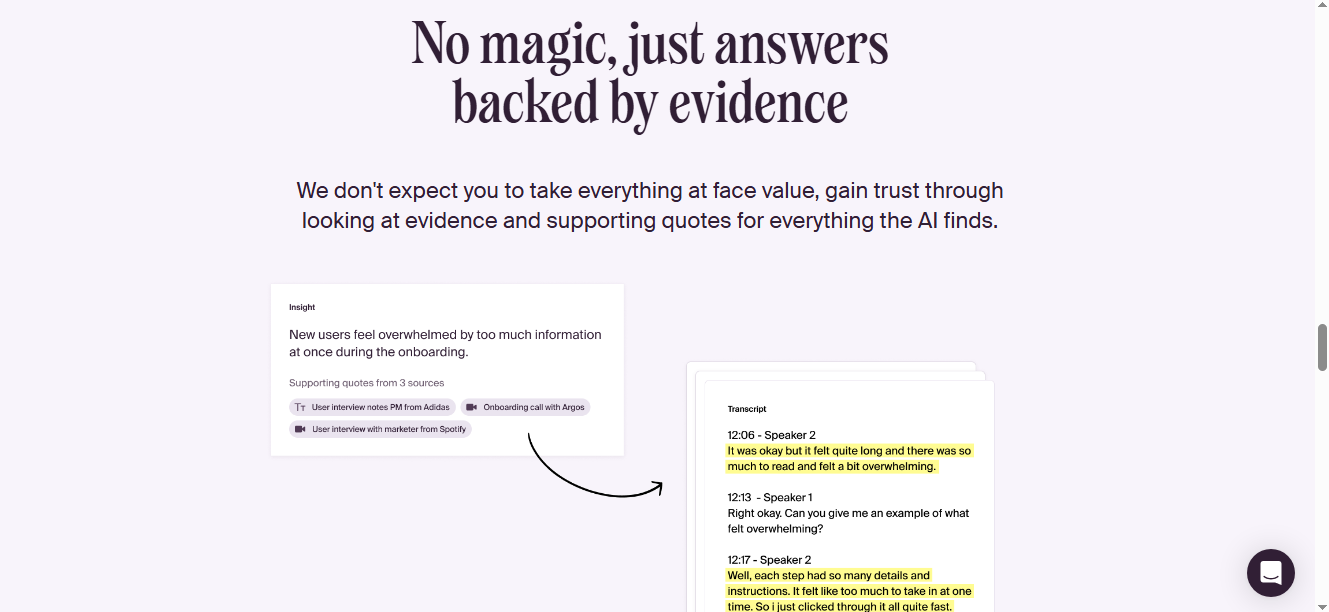In a marketplace overflowing with artificial intelligence tools boasting to supercharge every corner of our work lives, the essential question is, Can we trust what they do? When analyzing User interviews, a key step in truly understanding what customers think, feel, and want, there’s no place for vague insights or baseless assumptions.
That’s why the best research tools aren’t based on smoke and mirrors. They operate transparently, supporting every insight with hard evidence and quotes from users. The outcome is more than speed or convenience, it’s clarity, credibility, and confidence.
Researchers, designers, product managers, and marketing teams depending on a magic tool like Breyta that makes sense of the chaos right out of the box is a myth; Instead, they need a tool like this to speed up the finding of the truth to skillfully analyze, summarize and highlight the most relevant points from user interviews from every pitch, all with the real user voice at the back.
Let’s explore how evidence-backed AI tools are turning user interviews into actionable insight engines, and why this transition is a game changer for customer centric organizations.

Trust Starts With Evidence
Trust is earned through transparency, no matter how sophisticated a system may sound. The value of an insight is only as good as the ability to trace it back to its origin, which is true when analyzing user interviews.
Modern research platforms (like Breyta) make this a major tenet: no magic, only evidence-backed answers. For every theme, every finding, and every suggestion, there are quotes directly from participants. You’re not only seeing what the AI determined, you are seeing how it arrived at that determination.
This approach allows you to:
In essence, it achieves a balance of speedy action and thoughtful analytics, it provides the speed of AI with a safety net of manual audits.
The Problem with Traditional User Interview Analysis
Let’s be frank: traditional user research methods can be agonizingly slow.
Most teams conduct fewer interviews than they ought, postpone analysis, or get insights locked away in transcripts that no one has time to read. Scaling user interview analysis is difficult even with large research teams. And when deadlines are tight, the temptation to cut corners creeps in.
That’s where tools like Breyta come in not to take researchers out of the process, but to turbocharge their capacity to find and gather information more quickly, without compromising depth or trustworthiness.
AI That Assists, Not Replaces
That’s why experienced researchers love AI tools when they are built the right way. One product manager shared:
The ability to receive all the transcripts and insights in seconds, and to cross-check hypotheses based on so many participants, is truly a game changer. Using Breyta we still save loads of time since we do not have to check all key findings manually. I love it when Breyta doing the job, and doing it right.
This isn’t blind automation. It’s human-centered AI that does the low-level work—like transcribing interviews, finding patterns, and clustering themes, so you can do the thinking, honing, and sense-making. You don’t lose control. You gain superpowers.
From Raw Interviews to Reliable Insights—in Minutes
And here’s how Breyta and other similar tools can turn your wild scattered user interviews into trustable insights:
Upload Your Interviews
Transcription in Seconds
Thematic Analysis at Scale
Backed by Real Quotes
Test Hypotheses
Review and Refine
The Investigative Resources: Cross-check, Confirm, and Collaborate
In user research, single opinions can be misleading. That’s what makes cross-validation so crucial. It is painful to run this check in a traditional workflow e.g., whether the theme applies to 10 out of 20 users. With Breyta, it’s instant.
You can quickly answer:
That allows for more finely grained analysis the kind that decision-makers can trust. It also makes your work a much more collaborative one. Those interested can dive into being able to see themes and supporting quotes, and understand user feedback without anyone needing to “just give the TL, DR.”
Faster Doesn't Mean Shallower
One common misconception around AI tools is that the insight it provides is only a high-level overview. But if done carefully, they do lead researchers to burrow deeper than ever. Since the AI doesn’t get weary, or distracted, or influenced by the most recent interviews, it can detect:
Its very foundation is built on user quotes, so you know what it surfaces isn’t made up or misinterpreted. You can find the evidence for yourself.
The Creating a Culture of Evidence-Informed Decision Making
The impact of having your whole organization triage trusted insights from user interviews, supported by direct quotes and data, reaches far beyond the research team.
You can:
This creates an evidence-based decision-making culture instead of an assumption based decision-making, always centering the voice of the user.
Why It Matters More Than Ever
The age of AI-generated content, misinformation, and as-it-happens opinions makes it even more necessary to anchor your decisions in real user evidence. Tools that claim “magic” without displaying the receipts? Skip them.
But things that help you get to the truth more quickly, that explain their work, that help you go deeper? The future of user research lies in those. Because the truth is, it’s not AI replacing researchers. It’s about enabling researchers to be more trusted and effective and empowered.”
Conclusion
Be part of the product teams, UX researchers, and design leaders harnessing AI to transform user interviews into impact. Begin your free 14-day trial now and discover what it means to have answers backed by actual evidence, delivered in seconds. Your users have already told you. Only now is it time to listen to them?